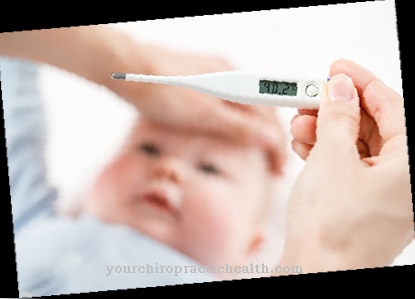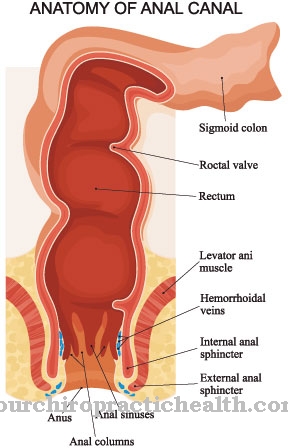Hypoxemia is a term for a low oxygen level in the blood. Various lung diseases can result in hypoxemia.
What is hypoxemia?
At a Hypoxemia the oxygen content in the arterial blood is decreased. The term hypoxemia is often used synonymously with the term hypoxia. Hypoxia actually describes the insufficient supply of organs and tissues with oxygen. The arterial blood is usually rich in oxygen. The normal value depends on gender and age.
In women, the physiological oxygen content in the arterial blood is 18.6 percent by volume, in men it should not fall below 20.4 percent by volume. The oxygen content in the blood is calculated using various auxiliary parameters. On the one hand, the oxygen saturation of the hemoglobin in the arterial blood (SaO2) and, on the other hand, the hemoglobin concentration in the arterial blood is required.
The hemoglobin concentration is given in grams per deciliter. The partial pressure of oxygen also plays a role in calculating the oxygen content in arterial blood. An oxygen content below 12 percent by volume is in the critical range. The hypoxemia causes the skin to turn gray or bluish in color. Shortness of breath, muscle weakness, and decreased consciousness are possible symptoms.
causes
Hypoxemia can have various causes. For example, a reduced oxygen supply in the ambient air leads to a lack of oxygen in the blood. In thin mountain air (over 3000 meters) there is significantly less oxygen. People who live at this altitude permanently have more red blood cells to make up for this lack of oxygen in the air. One speaks here of a polyglobule.
A lack of blood also leads to hypoxemia. Oxygen is transported with the help of hemoglobin. If there is a lack of hemoglobin, not as much oxygen can be bound. Anemia, known as anemia, can have a number of causes. These include iron deficiency, chronic bleeding, tumor diseases or vitamin B12 deficiency.
More often, however, the hypoxemia is caused by lung diseases. A disturbed gas diffusion within the lungs leads to a reduced uptake of oxygen. The gas diffusion can be disturbed by pulmonary edema, for example. Pulmonary edema is the accumulation of fluid within the lungs.
The edema can be caused by heart failure, cardiac arrhythmias, heart valve defects, drugs, toxic substances and by viruses, bacteria or fungi. Another cause of hypoxemia is cancer. Small cell bronchial carcinoma and bronchial carcinoma in particular limit the function of the lungs. Smokers are most commonly affected by these diseases.
The same also applies to chronic obstructive pulmonary diseases (COPD). Pulmonary emphysema can develop from COPD. The small structures of the lungs are over-inflated, so that no gas exchange can take place in the affected areas. The disease type "blue bloater" of the pulmonary emphysema is characterized by hypoxemia.
Hypoxemia can also result from an imbalance between pulmonary blood flow and pulmonary ventilation. Pulmonary embolism is an example of this. Here a thrombus becomes lodged in the vessels of the lungs. A heart shunt can also result in hypoxemia. A shunt is a connection between the normally separate parts of the body and pulmonary circulation. Deoxygenated venous blood enters the arterial vessels via the shunt.
Symptoms, ailments & signs
The symptoms of hypoxemia are often rather uncharacteristic and appear harmless at first glance. Those affected are constantly tired and dull. They complain of fatigue and poor concentration. In more advanced stages, exertion develops difficulty in breathing (dyspnoea). To make up for the lack of oxygen in the blood, the heart beats faster. The result is an increased pulse and palpitations.
In rare cases, cardiac arrhythmias can occur. In severe cases, hypoxemia impairs brain function. Patients feel dizzy or faint. Clouds of consciousness up to a coma are possible. The lack of oxygen makes itself felt in the heart by angina pectoris pain and a feeling of tightness in the heart area.
Diagnosis & course of disease
The clinical picture and anamnesis provide the first indications of hypoxemia. Long-term tobacco consumption, coughing with or without sputum, difficulty breathing when exercising and a bluish discoloration of fingers or lips can be seen as an indication of hypoxemia.
If hypoxemia is suspected, the carbon dioxide and oxygen levels in the blood are measured in a blood gas analysis. Blood gas analysis requires whole arterial blood or capillary blood from the fingertip. The evaluation is done automatically and only takes a few minutes. The blood gas analysis can therefore usually be carried out as an immediate diagnosis.
If the suspected diagnosis of hypoxemia is confirmed, the cause must be investigated. Further blood tests and imaging tests can determine the cause. X-rays, magnetic resonance tomography or computed tomography are possible examination options.
Complications
As a rule, hypoxemia always occurs when the patient has symptoms in the lungs or airways. The low oxygen level in the blood can have a very negative effect on the patient's health. This leads to severe fatigue and exhaustion. It is not possible to compensate for tiredness with the help of sleep.
In the case of diseases of the respiratory tract, severe shortness of breath also occurs, which in many cases leads to a panic attack. The affected person can lose consciousness and possibly injure himself if he falls. Feelings of dizziness and nausea occur, and the patient is no longer able to concentrate. The quality of life is severely restricted and reduced by the hypoxemia. Many activities from everyday life are no longer possible.
The cause of the hypoxemia is always treated, although the course of the disease is not always positive. Complications can arise if it is a carcinoma or heart failure. In these cases it is not uncommon for the patient to die.
When should you go to the doctor?
Hypoxemia usually manifests itself through rather uncharacteristic symptoms. A doctor should be seen if symptoms such as unusually severe tiredness and fatigue are noticed, possibly associated with an increased heart rate and palpitations. If an arrhythmia is suspected, it is best to consult a doctor immediately. Dizziness and a feeling of tightness in the heart area are clear warning signs that require an examination by the doctor.
Should further symptoms arise, the doctor must be consulted on the same day. People who have an eating disorder or a lung disease are particularly prone to developing hypoxemia. The symptoms mentioned should definitely be clarified in these cases. Children are best taken to the pediatrician responsible immediately. Specialists in lung diseases and nutritionists can also be called in. In the event of a medical emergency, the emergency number should be dialed. Any diagnosed hypoxemia must be closely monitored and treated by a doctor.
Doctors & therapists in your area
Therapy & Treatment
Therapy for hypoxemia depends on the cause. If the hypoxemia is based on pulmonary edema, the causal disease must also be treated here. Heart failure is treated with drugs that strengthen the heart, for example. Heart valve defects are treated surgically. If cancer is the cause of the oxygen deficiency, chemotherapy is usually carried out.
Surgery or radiation therapy can also be used to treat lung cancer. Lysis therapy is carried out for pulmonary embolism. The thrombus, which obstructs the pulmonary vessels, should be dissolved with medication. In severe cases, additional oxygen and reperfusion therapy are required. Surgical intervention may also be indicated.
You can find your medication here
➔ Medication for shortness of breath and lung problemsprevention
Smoking is the main risk factor for lung diseases like COPD or lung cancer. Cigarettes and other tobacco products should therefore be strictly avoided. Of course, hypoxemia can also develop in non-smokers, so that reliable prevention is not possible.
Aftercare
Following medical therapy, hypoxemia can be controlled by close medical supervision. Depending on who is responsible for the disease, heart-strengthening drugs may be used. In addition to medication during the follow-up treatment, the patients can actively participate in their own health improvement.
Not using nicotine basically has a positive effect on development. However, non-smokers can also suffer from the disease. In the aftercare phase, it is important that the affected people take sufficient breaks. With adequate sleep times at night, patients gradually feel better. A healthy, wholesome diet is also helpful.
In combination with light, sporting activities, the condition improves and the immune system becomes stronger. Lowering the stress level can also have a positive effect on the quality of life. Through targeted breathing exercises, those affected train their muscles so that the body then absorbs more oxygen.
How effective these approaches are will depend on the cause of the disease and the discipline of the patient. The aftercare can possibly be accompanied by homeopathic help. This is useful, for example, if there is pulmonary edema. However, self-treatment is less suitable for other cases.
You can do that yourself
The recommended therapies can be accompanied by appropriate rest breaks during the day and adequate sleep at night. A wholesome diet, a few less strenuous, persistent sporting activities and a reduction in stress can improve the quality of life.
In general, the respiratory muscles can be strengthened and built up. Gymnastic breathing exercises are advisable for this. Correct breathing can be learned and enables better oxygen absorption through the blood. Smoking, however, should be reduced as much as possible, but best stopped entirely.
Facilitation in dealing with the disease depends on the cause. If you have pulmonary edema, you can work with a homeopath. However, self-treatment should be avoided in the event of severe pleural effusion. If the cause is heart failure and the patient suffers from shortness of breath, it may be advisable to allow enough time for each task. Breaks are necessary and important. If the lack of oxygen is caused by a change in the spine, chiropractic treatment can also provide relief. In the event of a lack of oxygen that accompanies tinnitus, it makes sense to stimulate the blood circulation. Ginkgo is the plant of choice here. It is ideal for reducing noise in the ears and achieving a higher quality of life.





.jpg)





















